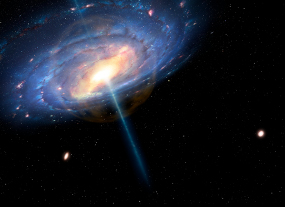XMM-Newton reveals the Milky Way's explosive past
29 August 2016
A giant bubble surrounding the centre of the Milky Way shows that six million years ago our Galaxy's supermassive black hole was ablaze with furious energy. It also shines a light on the hiding place of the Galaxy's so-called 'missing' matter. |
| Artistic representation of our Milky Way galaxy during an active phase. Credit: Mark A. Garlick/CfA |
While the mysterious dark matter grabs most of the headlines, astronomers also know that they have yet to find all of the normal, so-called baryonic, matter in the Galaxy. That has now changed thanks to the work of ESA's X-ray observatory XMM-Newton.
A thorough analysis of archival observations has shown that there is a vast quantity of baryonic matter scattered through the Galaxy. XMM-Newton found it in the form of gas at a temperature of one million degrees that permeates both the disc of the Galaxy, where the majority of the stars are found, and a spherical volume that surrounds the whole Galaxy.
The spherical cloud is vast. Whereas the Sun lies just 26 000 light years from the centre of the Galaxy, the cloud extends out to a distance of at least 200 000 – 650 000 light years.
Fabrizio Nicastro, from the Istituto Nazionale di Astrofisica, Osservatorio Astronomico di Roma, Italy, and his colleagues have been on the trail of the missing baryons for more than 15 years now. Their latest discovery with XMM-Newton shows that there is enough million-degree-hot gas in the Galaxy to account for it all.
It has remained undetected for so long because it does not emit visible light. Instead, the astronomers found it because the oxygen in the cloud absorbed X-rays at very specific wavelengths from light being emitted by more distant celestial objects.
And this was not the only discovery waiting in the data for the team. When it came to model the data with computer simulations to understand the way in which the gas was distributed around the Galaxy, the team did not get the answer they were expecting.
"According to simple gravitational physics you expect the density of the gas to decrease from the centre outwards," says Nicastro. In this picture, the density of gas will be at its peak in the centre of the Galaxy and at its least on the outer edges. But there was a hitch. "I spent three months trying to match the data with that model and I just couldn't," says Nicastro.
Having tried everything else, he moved the peak density away from the centre of the Galaxy. At a distance of about 20 000 light years from the Galaxy's centre the model fitted better. It was puzzling why this should improve things until he remembered that this distance is also the size of two large 'balloons' of gamma rays found in 2010 by NASA's Fermi gamma-ray observatory, which extend tens of thousands of light-years above and below the centre of our Galaxy.
So Nicastro constructed a different density model, in which there was a central bubble of low density gas extending out to 20 000 light years. When he applied this model to his X-ray data, he found that it fitted excellently.
"That was unexpected and very exciting at the same time," says Nicastro. It meant that something had pushed the gas outwards from the centre of the Galaxy, creating a giant bubble.
Astronomers know that there is a supermassive black hole at the centre of our Galaxy. It lies silent and dark these days but the bubble indicates that six million years ago things were very different.
The supermassive black hole was pulling stars and gas clouds to pieces and swallowing the contents. En route to annihilation, the doomed matter was heating up and releasing vast quantities of energy that snow-ploughed through the halo gas, opening up the bubble.
When astronomers look out into the wider Universe, they see that a small percentage of galaxies contain an extremely bright core. These cores are called active galactic nuclei, and as a result of this study astronomers now know that our Milky Way once had one of them.
Six million years later, the shock wave created by this activity has crossed 20 000 light-years of space, creating the bubble that XMM-Newton has seen. Meanwhile, the supermassive black hole has run out of nearby food and gone quiet again.
"I think the evidence for the Milky Way having been more active in the past is now strong," says Nicastro.
"We have taken a big step forwards with this result," says Norbert Schartel, ESA Project Scientist for XMM-Newton. "It means that the next generation of X-ray telescopes, such as ESA's ATHENA mission, will have plenty to study following its launch in 2028."
Notes for editors
A Distant Echo of Milky Way Central Activity closes the Galaxy's Baryon Census by F. Nicastro et al. 2016 is published in ApJL, 828, L12 (doi:10.3847/2041-8205/828/1/L12). A PDF of the accepted paper can be found at: http://arxiv.org/abs/1604.08210.
The European Space Agency's X-ray Multi-Mirror Mission, XMM-Newton, was launched in December 1999. The largest scientific satellite to have been built in Europe, it is also one of the most sensitive X-ray observatories ever flown. More than 170 wafer-thin, cylindrical mirrors direct incoming radiation into three high-throughput X-ray telescopes. XMM-Newton's orbit takes it almost a third of the way to the Moon, allowing for long, uninterrupted views of celestial objects.

